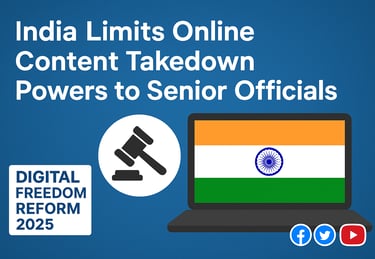India Limits Online Content Takedown Powers to Senior Officials | Digital Freedom Reform 2025
India restricts content takedown powers to senior officials, boosting transparency and digital freedom amid global scrutiny.
Raja Awais Ali
10/23/20252 min read


India Restricts Online Content Takedown Powers to Senior Officials Only
New Delhi, October 23, 2025 — The Government of India has announced a significant overhaul of its online content moderation rules, limiting the power to remove digital content to only a few senior officials. The new framework aims to create a balance between freedom of expression and government oversight on social media platforms.
According to the Ministry of Electronics and Information Technology (MeitY), the new policy ensures greater transparency and accountability in how online content is regulated. From now on, only officers holding the rank of Joint Secretary or above, and police officials equivalent to Deputy Inspector General (DIG), will have the authority to issue takedown orders.
This move follows a long-running legal dispute between the Indian government and the U.S. social media platform X (formerly Twitter), owned by Elon Musk. The company had challenged India’s previous content removal orders, claiming that the rules granted “excessive powers” to mid-level bureaucrats to silence dissenting opinions or politically sensitive content.
Previously, thousands of officials could order the removal of posts, videos, or articles citing national security or public order concerns. Critics argued that such unrestricted powers led to over-censorship and a chilling effect on free speech.
Under the new regulations, any request to take down content must include a written justification (Reasoned Notice), clearly stating the legal provision, the nature of the violation, and the targeted URL. Affected users will also be given the right to appeal, allowing them to challenge content removal orders.
The ministry stated that the reforms aim to strengthen digital governance and prevent the misuse of takedown powers. “Our goal is to ensure lawful, proportionate, and transparent regulation in the digital space,” the ministry said in a statement.
The updated policy, set to take effect on November 15, 2025, requires the government to conduct monthly reviews of all takedown directives issued under the new framework. This change is expected to improve accountability and reduce arbitrary removals.
Technology analysts have welcomed the decision, calling it a “progressive step toward responsible digital reform.” They believe that this new system will limit government interference and give platforms like Facebook, YouTube, and X more operational autonomy. However, civil rights groups caution that implementation will be key, as transparency and judicial oversight remain critical for protecting free expression.
Globally, the move has been seen as part of India’s broader push toward modernizing its digital governance, while facing mounting international scrutiny over online censorship.
Conclusion
India’s decision to restrict content takedown powers to senior officials marks a major shift in the country’s digital policy landscape. By narrowing the scope of authority and enhancing transparency, the government seeks to balance national security with citizens’ freedom of speech. Whether these reforms can be implemented effectively, however, remains the real test of India’s commitment to digital democracy.